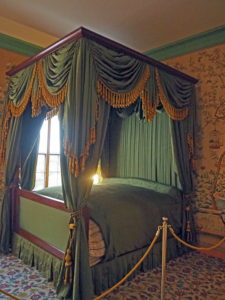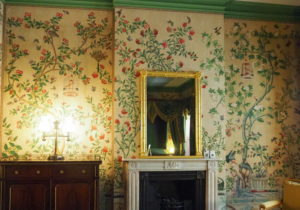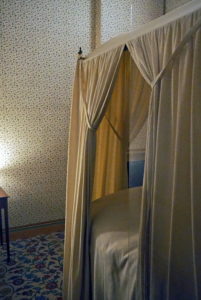The Yellow Bow Rooms, named after the shape of their windows, look out over the front of the Royal Pavilion. These were originally the bedrooms of George IV’s brothers, the Duke of York and the Duke of Clarence, who later became William IV.
The walls are covered in a lurid chrome yellow paint, a chemical pigment which had only just become commercially available, and George was one of first to use it.
The first room was used by the Duke of York. The massive pair of lacquered hat boxes were made in China for the Prince of Wales. The far room belonged to the Duke of Clarence and has two black and gold lacquer secretaires.
Between the two rooms is a smaller room, described as the servant’s room which contains a mahogany wash stand.
Queen Victoria’s Bedroom is on the opposite side of the galleries to the Yellow Bow Rooms.
Queen Victoria first visited the Royal Pavilion in 1837 and was not impressed, describing it as a ‘strange, odd, Chinese looking place, both outside and inside’. She returned for a longer stay with her husband Albert and two children in 1842 and the upstairs chamber floor was adapted to accommodate the Queen and her family. The family used the south galleries as breakfast and lunch rooms.
Victoria never liked the Royal Pavilion. Not only did it not provide the space and privacy she wanted, she also wanted to distance herself and the monarchy from the extravagance and indulgence of the Regency era. She sold the Royal Pavilion to the town of Brighton who converted most of the top floor to an exhibition area and civic space.
Three rooms have been restored to what they might have been like when used by Victoria, including a water closet.
Queen Victoria’s Bedroom is furnished with a reproduction of an 1830 four poster bed, which would have had six mattresses of straw, hair and feathers.
The walls are covered with early C19th hand painted Chinese Export Wallpaper. These were the height of fashion. The paper was produced in sets hung to form a continuous but unrepeating scenes of flowers, trees, birds and stylised gardens.
Next door is the small room belonging to the maid which had a small fireplace. The bed is hung with white dimity cloth. The wallpaper is a reconstruction of the original.
This is the end of the tour, which returns to the ground floor and out through the shop.










